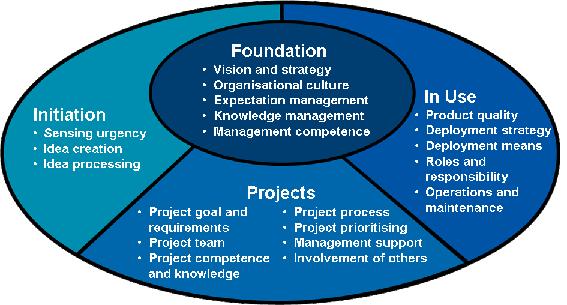Subjects:
Software test
ImprovAbility™ model
Seminars / Presentations
Reports / Papers

Subjects:
Software test
ImprovAbility™ model
Seminars / Presentations
Reports / Papers
1. Capability Maturity Model for Software, Version 1.1, 93-TR-024 (1993), Paulk M.C., B. Curtis, M.B. Chrissis, and C.V. Weber, Software Engineering Institute, Pittsburgh, Pennsylvania.
2. BOOTSTRAP 3.0: Software Process Assessment Methodology (1998), Bicego A., M. Khurana, P. Kuvaja, Proceedings of the SQM'98.
3. CMMI: Guidelines for Process Integration and Product Improvement (2003), Chrissis, M.B., M. Konrad, and S. Shrum, Addison-Wesley Professional, Boston, MA.
4. ISO 15504-7: Assessment of organizational maturity (2008), International Standardization Organisation.
5. ImprovAbility™ Success with process improvement (2013), Pries-Heje, J. and J. Johansen eds., DELTA, Hørsholm, Denmark. Foreword by Alec Dorling.
6. The ImprovAbility™ Model (2007), Pries-Heje, J. and J. Johansen, M. Christiansen, M. Korsaa, CrossTalk Vol 20 No.2
7. ImprovAbility™ Guidelines for Low-Maturity Organizations (2008), Christiansen, M. & J. Johansen, Software Improvement and Practice, 13, 319-325, Wiley Interscience, DOI:10.1002/spip.393.
8. ISO 33014: Software and Systems Engineering - Guide for process improvement (2012), International Standardization Organisation.
9. A Framework for Classification of Change Approaches Based on a Comparison of Process Improvement Models (2006), Vinter, O., DELTA, Hørsholm, Denmark.
10. A Framework for Selecting Change Strategies in IT Organizations (2006), Pries-Heje, J. and O. Vinter, DELTA, Hørsholm, Denmark.
The approach that most companies choose to base their software process improvements (SPI) on is to adopt one of the well-known models of software maturity. Improvement actions follow a predefined model where a company's processes are improved on a broad scale, with the aim to move the company to higher levels of maturity. The original models were: CMM® [1] and BOOTSTRAP® [2]. CMMI® (Capability Maturity Model Integrated) [3] is the latest and most widely adopted example of a model based on the ranking of process improvement areas in maturity levels. These maturity models have been combined in ISO 15504 (SPICE) [4].
Other models to improve a company’s software processes are not based on maturity levels. They identify and prioritise the most important (process)problems from the specific viewpoint of the company, and seek to improve these first. The ImprovAbility™ model [5][6][7], which is presented below, is an example of such a model. The ImprovAbility™ model has been adopted in 2012 as an ISO standard (ISO 33014) [8].
All these improvement models, however, are based on a predefined set of process areas, which must be improved. An alternative and less formal way of performing improvements can be based on the actual experiences of the company. Various "problem diagnosis" techniques identify and prioritise the most important (process) issues as perceived by the organisation and improve these first. Such a problem diagnosis technique could be analysis of error reports (defect analysis).
At DELTA I have been deeply involved in studying factors which promote or impede process improvements succeeding in companies. This took place as part of a large Danish research project (Talent@IT 2003-2006) involving the IT-university of Copenhagen, DELTA as research organisation, and the IT organisations in four commercial companies primarily from financial sector. This work resulted in the ImprovAbility™ model for improvement and innovation. The model comprises 20 parameters in 4 categories:

The ImprovAbility™ model and accompanying assessment method provide an organisation with a view of their strengths and weaknesses with respect to improvement and innovation on each of these parameters.
The model also exists in a variant, which can be used to assess a project’s chance for success or failure early in development – typically when the requirement specification exists and the core project team has been assigned. This variant of the model is based on those 17 parameters that are relevant for projects.
A complete description of the model and the results we obtained during the Talent@IT project can be found in the book: ImprovAbility™ - Success with process improvement [5] and in two shorter papers [6][7].
As part of our research we studied possible ways of improving the parameters. For example we studied several different types of improvement project life-cycle models (SPI, IT implementation and BPR) as one basis for a catalogue of approaches for improvements: A Framework for Classification of Change Approaches Based on a Comparison of Process Improvement Models [9].
Other change approaches were related to organisational change strategies for which we developed a separate model (The Change Strategy Nexus) that was presented at several conferences e.g. at PROFES06: A Framework for Selecting Change Strategies in IT Organizations [10] and included in the ISO standard (ISO 33014) [8].
Return to top of page.
Seminars and Presentations
I and several other former DELTA process consultants (now at Whitebox) give presentations of the model, method, and our experiences with it varying from 45 minutes to 2 hours depending on your needs. We perform assessments of organisations as well as individual projects. We have also created a one week training course where you can learn how to perform project assessments in your own organisation. You can get more information on these offers by contacting me.
Return to top of page.

|